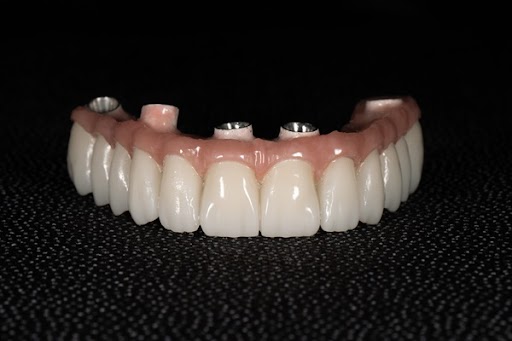Do I Need a Root Canal Modesto, CA
Root canal treatment repairs and restores severely damaged teeth that are affecting the tooth's roots. The treatment aims to relieve pain and save as much natural tooth structure as possible. Going without treatment when a root canal is necessary can have dire effects on surrounding teeth, gums, and bone.
Root canal treatment is available at Great Smiles Dental in Modesto and the surrounding area. We can determine whether a root canal is necessary and help relieve your pain. Call us today at (209) 222-3636 to schedule an appointment or learn more about our services.
Pain Relief Through Root Canal Treatment
Root canal treatment aims to relieve pain first and foremost. Many patients experience pain as the main symptom and feel it develop beyond a simple toothache. Pain can stem from deep in the bone of a tooth and feel like the entire tooth or area of their mouth is aching. In many cases, a patient may also experience referred pain, which is pain felt in a different spot than that where the actual injury lies.
Root canal treatment resolves pain by removing decay and infection from inside the tooth's pulp and replacing infected roots with artificial ones. This way, we can help save the natural tooth structure and the tooth itself. The longer people avoid seeking this treatment, the pain can cause a dead tooth and require more intensive procedures such as an extraction.
“Root canal treatment resolves pain by removing decay and infection from inside the tooth’s pulp and replacing infected roots with artificial ones.”
When to See a Dentist About Root Canals
Many different factors may contribute to a patient needing a root canal. These conditions can manifest themselves as various symptoms. These include chips or cracks in teeth, pain while eating or touching the tooth, persistent pain, sensitivity to heat and cold, and swollen gums.
Chips or cracks in the tooth allow empty spaces for bacteria to settle in and cause infection and inflammation, while tooth sensitivity may be a sign of severe decay or nerve damage. In general, toothaches are a sign a patient should see a dentist.
Tooth sensitivity may linger longer when the blood vessels and nerves in the tooth have become infected or damaged. Swelling may also come and go. It is frequently associated with abscesses, which may be accompanied by unpleasant taste and odor.
Infected teeth may also feel looser than healthy teeth, due to nerve death softening the bone. Furthermore, teeth may turn grayish-black when the roots have been damaged and the internal tissue has been broken down.
“These conditions can manifest themselves as various symptoms.”
When Root Canals Are the Only Option
Root canal treatments are necessary when the pulp of the tooth has become inflamed or infected and needs removal. This may happen due to deep decay, cracks or chips in the tooth, faulty crowns, and repeated dental procedures. Patients should also be warned that facial trauma may still damage the pulp even when the tooth does not have visible chips or cracks. Leaving pulp inflammation or infection untreated may lead to pain or the formation of an abscess.
When left untreated, teeth with damaged pulp eventually die. This can negatively impact your overall oral health, as well as make it difficult to eat and chew. Root canals can help preserve the remaining tooth. The procedure may be followed by the placement of an implant or a crown.
“Root canal treatments are necessary when the pulp of the tooth has become inflamed or infected and needs to be removed.”
Check out what others are saying about our dental services on Yelp: Do I Need a Root Canal in Modesto, CA
Alternative Treatments
A root canal is the only treatment that can help save a tooth that requires a patient has enough natural tooth structure to work with. For cases in which the patient does not, the only alternative treatment is an extraction with tooth replacement options that include a crown, bridge, or implant.
Extractions are necessary when a patient has a root fracture, an insufficient amount of remaining tooth structure, a significant amount of tooth resorption, or multiple past root canals. An extraction can preserve surrounding teeth, gums, and bone by preventing the infection from spreading. Without root canal treatment or extraction, the entire area becomes at risk.
“Root canals become necessary when a patient experiences or notices persistent pain, swollen gums, sensitivity to hot and cold stimuli, tooth discoloration, a chip or crack, and tooth mobility.”
Questions Answered on This Page
Q. Do I need a root canal procedure?
Q. When are root canal treatments necessary?
Q. Do I need an emergency root canal?
Q. Can I get pain relief through a root canal treatment?
Q. Are there any alternatives to root canals?
People Also Ask
Q. How common are root canals?
Q. What are the benefits of a root canal?
Q. How can I cope with dental anxiety or phobia?
Q. How can you save a tooth with a root canal?
Q. Are pain and tenderness when touching the teeth or chewing a sign of a problem?
Q. What are the services offered endodontists vs. general dentist?
Emergency Root Canals
Since every tooth that requires a root canal is in the process of dying, patients should consider every root canal an emergency procedure. Delaying treatment will only increase the chances of pulp necrosis, or having the pulp of the tooth die off entirely. Only a root canal procedure or tooth extraction can reverse the symptoms of pulp necrosis. When left untreated, pulp necrosis may put patients at risk for infection, fever, jaw swelling, cellulitis, abscesses (including those in the brain), sinusitis, periodontitis, and bone loss. Contact our office immediately if you are experiencing severe toothaches when biting down or chewing, sensitivity to hot or cold temperatures (especially hot), darkening or discoloration of the teeth, swelling or tender gums, and pimples on the gums.
“Since every tooth that requires a root canal is in the process of dying, patients should consider every root canal an emergency procedure.”
Frequently Asked Questions
Q. Do root canals hurt?
A. Root canals today are similar to a deep filling treatment and should not hurt. With local anesthesia, we keep patients comfortable and pain-free throughout the procedure and a few hours after. We will also prescribe pain-relievers and antibiotics to help the site heal quickly.
Q. How often will I need a root canal?
A. Once a root has been removed and replaced, it will no longer need retreatment. However, if decay lingers in the site, an extraction may be necessary later down the line. Tooth replacements may need replacement every 5-10 years, depending on its type and maintenance by the patient.
Q. How long does it take to get a root canal?
A. This varies on a case-by-case basis. However, most patients can expect one or two 90-minute appointments.
Q. How much do root canals cost?
A. Root canal treatment differs for everyone depending on the location of the tooth, severity of the condition, and amount of work needed to be done. On average, a root canal treatment can cost anywhere from $750 to $1,500. We recommend communicating with your insurance provider to understand your plan and coverage.
Q. How does a root canal treatment work?
A. Using X-rays from the initial consultation, we can see how the roots are shaped and where exactly the infection lies to ensure we only remove what is necessary. During the treatment, we will remove the entire pulp chamber and any infected roots. Then, we will replace them with artificial roots, clean the inside, place back the pulp chamber (if unaffected), and seal the tooth.
Q. How can I prevent root canal treatment?
A. As root canals are a result of severely decayed or damaged teeth, it is important to exercise basic oral hygiene habits to prevent even a small cavity. Cavities are the earliest sign of decay and going without treatment allows this decay to develop and reach the tooth's roots. It is important to practice good oral hygiene, visit the dentist regularly, and avoid foods and beverages that cause cavities.
Dental Terminology
Learn More Today
For many patients, a root canal procedure is just what they need to save their tooth. We at Great Smiles Dental may be able to help. Call us today at (209) 222-3636 to learn more and schedule an appointment.
Helpful Related Links
- American Dental Association (ADA). Glossary of Dental Clinical Terms. 2024
- American Academy of Cosmetic Dentistry® (AACD). Home Page. 2024
- WebMD. WebMD’s Oral Care Guide. 2024
About our business, license, and website security
- Great Smiles Dental was established in 2014.
- We accept the following payment methods: American Express, Cash, Check, Discover, MasterCard, and Visa
- We serve patients from the following counties: Stanislaus County and San Joaquin County
- We serve patients from the following cities: Modesto, Oakdale, Turlock, Tracy, Stockton, Lathrop, Ripon, Atwater, Salida, Manteca and Ceres
- CA (License #33512). View License Information and Specifics
- National Provider Identifier Database (1629180617). View NPI Registry Information
- Healthgrades. View Background Information and Reviews
- Norton Safe Web. View Details
- Trend Micro Site Safety Center. View Details
Back to top of Do I Need a Root Canal











